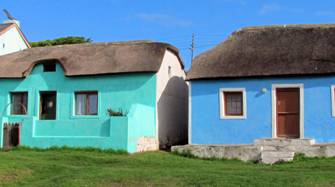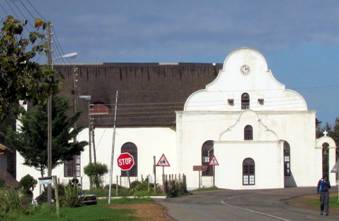DAY TRIPS FROM STANFORD:
De Kelders, Baardskeerdersbos, Elim and environs
(About 150km round trip) - Leave Stanford by going up Queen Victoria Street towards the R43. Turn right to Gansbaai. About 500 m down the road you pass Stanford's Business Park on your left and a bit further down the road on the right are the houses constructed by the government for the disadvantaged people of the area. This is an ongoing process.
On cresting the rise, the road to Gansbaai lies like an undulating rollercoaster before you. To your right is one of the chicken farms operating around Stanford.
The R43 traverses vegetation known as Renosterbos fynbos. This is the generic term for the blackish/grey knee-high bushes dispersed with mainly Proteas and Ericas fynbos. The mountain to the left turn into a pink mass of Ericas in season. These Ericas are unique to this mountain. Further down the road a beautiful view of Walker Bay appears to your right.
Take the first turn off right to "De Kelders". Go straight down the road and park overlooking Walker Bay. If you are here in the height of the whale season, July to October, you are sure to see these large mammals frolicking in the sea. They come here to calve and mate so you are sure to see some calves as well. Just around the corner you will find "Coffee on the Rocks" where you can enjoy some refreshments and maybe see some more whales breaching or lop-tailing. The theory is that a whale will breach (jump out of the water) three times – so watch where it breached and you may see it breach again.
Now that you are refreshed and replenished, proceed along Cliff Road to the second stop sign. Turn right. If you are looking for a small sheltered beach to spend the day on, turn left at the stop street (into De Villiers Street) and continue down the road until you arrive at Cape Nature's boom across the road. You will need to pay a required entrance fee to get to the beach. (Entrance is free should you have a conservation Wild Card, which is issued by CapeNature or SANParks.)
If you feel you would rather do some more sightseeing, then turn right and not left at the above-mentioned stop sign. At the next stop sign turn left toward the R43. Take the road back to Stanford so you can explore inland and leave Gansbaai for another day.
About 3 kilometres back along the R43 you get the turnoff to Grootbos Lodge on your right. The largest remaining forest of indigenous Milkwood trees (South Africa's national tree and one of its most protected species) is to be found here. Day or half-day tours of the forest and/or fynbos should be arranged beforehand, as well as other environmental tours. Our local tourism office can be of assistance.
Further along the dirt road (quite passable by 'normal' sedan cars) you will find "Platbos" on the right at the foot of the hill. This is well worth a visit. As you wander beneath the forest canopy amongst the old twisted and gnarled Milkwood tree trucks and branches, a sense of calm and peacefulness prevails. If you look intently at the old tree trunks you may see a forest fairy.
On leaving Platbos turn right. At the following "T" junction you should turn left to Baardskeerdersbos (difficult to pronounce – we just call it B'bos). The dam you eventually pass on your left is the Kraaibos Dam (literally meaning "bush of crows") built by local farmers and the Gansbaai Municipality. The water is used by farmers for irrigation purposes (as you can see from the surrounding vineyards) and by the municipality for potable water.
The road continues through farms. You will then get to Baardskeerdersbos. Its name derived from the Afrikaans name for the spider-like insect that uses hair (even human hair if as the story goes you happen to be sleeping on the ground) to make its nest. Literally translated it means beard shavings' bush. Turn left into the village. This quaint little village has become a haven for artists of all sorts – some of them even exhibiting as far as New York and London. On occasions, when advertised, there is an open weekend when you can visit the various artists in their studios. One of the artists also offers a bread-making course every last Thursday and Friday of the month. Some very good art forms are represented here. In the village itself, it is told that the bell in front of the church tolls by itself. Hope you hear it.
When in B'Bos, do please quench your thirst at one of the pubs, or have a late breakfast/light lunch at the roadside bistro, as your next stop, Elim, does not have very much to offer in the light of refreshments.
Once you've experienced the quirkiness of B'Bos, continue along the road and follow the signs to Elim, one of the old Moravian missionary stations in the Western Cape. Bird watchers should look out for blue cranes (South Africa's national bird), spur wing geese, small raptors etc. along the route. (You pass a turnoff to Stanford, but continue straight ahead to Elim.)
On entering Elim with its whitewashed thatched roofed cottages you are struck by the imposing church at the end of the road. This village was established by German Moravian missionaries in 1824 and is one of several in the Cape. The church yard, which comprises the imposing church, as well as the Old Mill House, has been proclaimed a national monument. The Mill House had a restored water wheel reputed to be the largest wooden water wheel in South Africa, and which was used to grind corn. The old bakery and general dealer form part of the church "werf" (yard) area. The "Elim Tehuis" is situated on the road leading from the church to the right. It is home to 50 children and adolescents with spastic paralysis and other serious disabilities.


After the abolition of slavery in 1834, many freed people settled in Elim and hence Elim boasts the only monument in South Africa commemorating the liberation of slaves.
The Geelkop Nature Reserve, a few km out of town harbours one of the remaining patches of so-called "Elim Fynbos" a vegetation type that is restricted to a small part of the Overberg around Elim. The Geelkop reserve is not very big (450 ha), but since the plants are dwarf fynbos species which belong to the rarest plant species on earth it perhaps does not need so much space. The land still belongs to and is managed by the Moravian Church in Cape Town. Contact the tourism office in Elim for directions and a possible guide.
Take the road back towards Baardskeerdersbos and turn right at the Stanford turnoff (you passed it on the way to Elim). The road winds through the hills of the Overberg past Papiesvlei, a farm school, and eventually joins the R326 outside Stanford.
After a day of driving a good meal with a glass of excellent wine or beer is called for. Visit one of the many restaurants and pubs in Stanford.